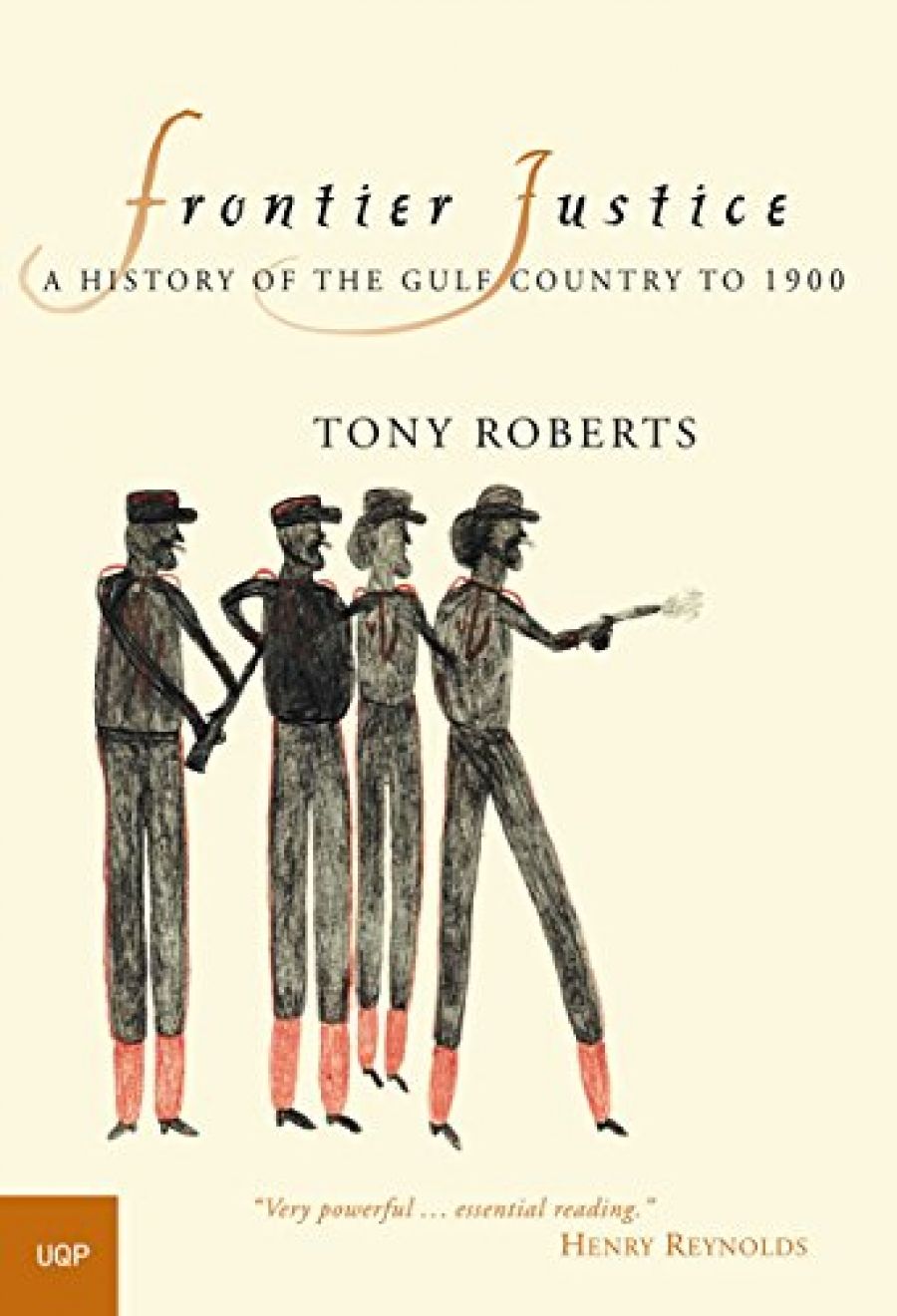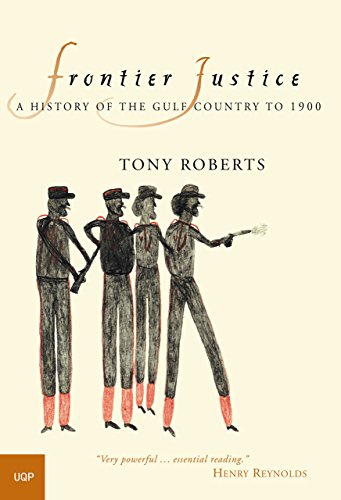
- Free Article: No
- Contents Category: Australian History
- Review Article: Yes
- Article Title: Talking English
- Online Only: No
- Custom Highlight Text:
The country south-west of the Gulf of Carpentaria, where wild rivers tumble from stony ramparts through coastal scrub plain to the sea, was one of the last places in Australia where settlement was attempted; more integrated with Asia to the north – thanks partly to the sojourning Macassans – than Melbourne or Sydney to the south, let alone London; a world where Aboriginal society was strong enough to resist dispossession, surviving, despite everything, to this day. It has also been something of a last frontier for historians.
- Book 1 Title: Frontier Justice
- Book 1 Subtitle: A History of the Gulf Country to 1900
- Book 1 Biblio: UQP, $32.95pb, 321pp, 0 7022 3361 7
- Book 1 Cover Small (400 x 600):

- Book 1 Cover (800 x 1200):

Tony Roberts tells that story year by year, place by place, man (mostly) by man. He follows the footpad of diarists, interviewers, linguists, journalists, land rights commissioners and family historians, accumulating evidence that a less attuned researcher might have passed over. His book is like one of those thousand-piece jigsaw puzzles in which every piece must be examined until its place is found, its contribution to the bigger picture slowly revealed – in all its horror. The author’s conclusions are summarised by two charts. One lists European deaths from misadventure in the area, including Aboriginal attacks, between 1872 and 1916: a total of forty-two individuals. The other lists fifty-three multiple killings of Aborigines (‘massacres’) in the same period, amounting to hundreds of individuals dead. The imbalance of the violence is starkly apparent.
Roberts tells us that he started travelling north from Adelaide in the 1960s. By 1974 he had reached Borroloola, the tiny ‘capital’ of the Gulf Country, notorious once as the resort of ‘all the scum of Northern Australia’. To his surprise, he found that Charley Havey, who had lived in Borroloola since about 1906 and acted as local magistrate and coroner for more than thirty years, was his great-grand-uncle. A piece of family history then expanded into a study of the old white men who chose to live out their days far from civilisation in what was sometimes described as lotus-eating land. But the so-called European ‘hermits of Borroloola’ were not hermits at all. They were integrated with, and dependent on, the Aboriginal population of the area who owned the real history of the town.
Aborigines, from a number of surviving language groups, were in Borroloola seasonally because they had ‘come in’, often in a terrible state, as a result of the dislocation, killings, kidnappings, rapes, disease and other depredations of colonisation. Their world had been turned violently upside down by the invaders. At least one language group no longer existed. To understand the terrain and contours of Borroloola’s past in any depth, Roberts had to look to the wider history of black-white contact in the Gulf. And once he started to look, he was astounded by what he found. ‘I was totally unprepared for both the quantity of archival material that existed and its disturbing content,’ he admits. He had come along just in time. There were still people alive wanting to tell stories they held in living memory. Whylo McKinnon, for example, a Yanuwa elder from Vanderlin Island, offshore from Borroloola, told Roberts of hearing Karrara – one of the accused – speak of the murder of Thomas Perry, brutal part-owner of Cresswell Downs in 1896.
For decades, Roberts has been collecting such information as it disappeared, and learning to interpret what was already there. It is striking how many of his sources are descendants of those involved in this mostly unlovely history, which the author enlivens with fascinating incidental material and a sustained sense that what happened in the Gulf is linked to life in the rest of Australia. I don’t know how many miles Roberts has travelled by car or on foot, how many hours he has communicated by telephone or email, how many documents he has checked out, to connect our curious, conscience-troubled present with a grim past that has been veiled from understanding. His findings seem incontestible, although the casualties of the ‘virtual warfare’ he uncovers in the Gulf at the end of the nineteenth century are unlikely to be memorialised as we do other tragedies of empire, such as Gallipoli.
Roberts’s verdict on his great-grand-uncle in Borroloola is that ‘the justice Havey dispensed in the old courthouse was rough but fair’. The remark points to the book’s central concern, signalled in the title: Frontier Justice. Roberts comes along as both detective and latter-day judge, reviewing the evidence in a forensic way, empirical rather than theoretical. The double standard appals him more than anything: ‘the same British laws that authorities ignored when Aboriginals were the victims, were applied rigorously when they were the unknowing offenders.’ He argues that the administration’s failure to enforce the law in the Gulf was a way of tacitly condoning the violence being perpetrated: ‘Station managers and stockmen were free to seize the waterholes at gunpoint and to deal with the local Aboriginal peoples as they wished, without hindrance. This appears to have been a deliberate policy …’
Roberts quotes those who protested against the situation. He mentions station owners who managed peaceable relations with Aborigines. But given that the settlers’ unveiled aim was to occupy the land, he is realistic about whether it might have been different. He quotes a regretful old cattleman saying that ‘it was unfair of governments to throw on pioneers the responsibility for aggression, and to force them, or allow them, to take the law into their own hands’. The linguistic subterfuge shows that even participants were uncomfortable about what they were doing. ‘The system termed “dispersing the natives”, which simply means shooting them, is not to be practised,’ wrote Northern Territory Police Inspector Paul Foelsche disingenuously in 1885, covering his back. ‘It’s no use mincing matters,’ said one rogue policeman of such a dispersal, ‘the Martini-Henry carbines at this critical moment were talking English.’
Aborigines could use harmless-looking locutions, too. One old-timer spoke of ‘that big ride-round through the ranges’ to describe a frenzy of revenge killing by a posse of stockmen. Not all were as direct as Sandy Mambookyi and Chicken Gonagun, who told interviewers in the 1970s: ‘Some kid, piccanin’, that small one, like a goanna, hittem longa tree … Bash ‘em longa stone, chuckem longa stone … You know, too small to shoot ‘em, too small … Oh, they bin like to killem, finishem up tribe. Take all of their country.’ The author is careful with his own language and citation, aware that he is operating in an environment of massacre-deniers and black-armband scoffers. Yet the implication of his enterprise is that, under the eye of eternity, it is never too late for justice to be done.
I salute the service that this independent historian has done us. It is hard to see how such long-gestated, footsore and substantial work could have emanated from the academy, even on an Australian Research Council grant. I congratulate the beleaguered University of Queensland Press for publishing the book so well, with extensive apparatus and a generous swag of unfamiliar photographs. When I was in Borroloola a few years ago on the trail of Roger Jose, the town’s most eye-catching eccentric, people kept telling me about this man down south who had all the information. Tony Roberts must have spoken to everyone there. They kept asking when his book would be out. Here at last, truly long-awaited, is the story to 1900. We can only hope that author and publisher make good of the hint that the next instalment is not far behind.


Comments powered by CComment